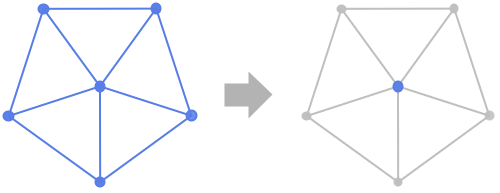GraphHub[g]
gives the set of vertices with maximum vertex degree in the underlying simple graph of g.
GraphHub[g,"In"]
gives the set of vertices with maximum vertex in-degree.
GraphHub[g,"Out"]
gives the set of vertices with maximum vertex out-degree.
GraphHub[{vw,…},…]
uses rules vw to specify the graph g.


GraphHub
GraphHub[g]
gives the set of vertices with maximum vertex degree in the underlying simple graph of g.
GraphHub[g,"In"]
gives the set of vertices with maximum vertex in-degree.
GraphHub[g,"Out"]
gives the set of vertices with maximum vertex out-degree.
GraphHub[{vw,…},…]
uses rules vw to specify the graph g.
Details

- The vertex degree for a vertex v is the number of edges incident to v.
- For a directed graph, the in-degree is the number of incoming edges and the out-degree is the number of outgoing edges.
- For an undirected graph, an edge is taken to be both an in-edge and out-edge.
- GraphHub works with undirected graphs, directed graphs, multigraphs and mixed graphs.

Examples
open all close allScope (5)
Applications (7)
The administrator is the hub of the friendship network between members of a karate club:
Find the people with the most family members present at the family gathering:
Find the publications with the most citations in a citation network:
With the most references to other publications:
The terrorist network linked to the tragic events of September 11, 2001. The ringleader of the conspiracy is the hub of the network:
The Medici family is the hub of the marriage network of the ruling families of Florence:
It is the most powerful family and has the highest betweenness centrality:
Find the stations with the largest number of neighboring stations in the London Underground network:
Find the messages receiving the largest number of replies in the network of email sent to the MathGroup list in November 2011:
The most interesting subject of the month:
Compute the message generating the largest total number of messages:
Properties & Relations (11)
GraphHub gives the center of a graph with respect to DegreeCentrality:
With respect to in-degree centrality:
With respect to out-degree centrality:
For simple graphs, GraphHub gives the center with respect to VertexDegree:
Or with respect to VertexInDegree:
Or with respect to VertexOutDegree:
For a CompleteGraph, every vertex is a hub:
For a PathGraph, all vertices except for the endpoints are hubs:
For a CycleGraph, every vertex is a hub:
For a WheelGraph of size 5 or more, the hub of the wheel is the graph hub:
For a GridGraph, all vertices that are not at an edge of the grid are hubs:
For a CompleteKaryTree, all vertices except for the leaves and the root are hubs:
The center of a graph with respect to EccentricityCentrality is obtained with GraphCenter:
The set of vertices with maximum VertexEccentricity is obtained with GraphPeriphery:
The BetweennessCentrality center of a graph:
The ClosenessCentrality center:
The EigenvectorCentrality center:
Possible Issues (1)
Self-loops are not accounted for:
Use VertexDegree to find the center with self-loops included:
Related Guides
Text
Wolfram Research (2012), GraphHub, Wolfram Language function, https://reference.wolfram.com/language/ref/GraphHub.html (updated 2015).
CMS
Wolfram Language. 2012. "GraphHub." Wolfram Language & System Documentation Center. Wolfram Research. Last Modified 2015. https://reference.wolfram.com/language/ref/GraphHub.html.
APA
Wolfram Language. (2012). GraphHub. Wolfram Language & System Documentation Center. Retrieved from https://reference.wolfram.com/language/ref/GraphHub.html
BibTeX
@misc{reference.wolfram_2025_graphhub, author="Wolfram Research", title="{GraphHub}", year="2015", howpublished="\url{https://reference.wolfram.com/language/ref/GraphHub.html}", note=[Accessed: 07-January-2026]}
BibLaTeX
@online{reference.wolfram_2025_graphhub, organization={Wolfram Research}, title={GraphHub}, year={2015}, url={https://reference.wolfram.com/language/ref/GraphHub.html}, note=[Accessed: 07-January-2026]}